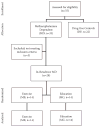Exercise training improves heart rate variability after methamphetamine dependency
- PMID: 24162556
- PMCID: PMC3999306
- DOI: 10.1249/MSS.0000000000000201
Exercise training improves heart rate variability after methamphetamine dependency
Abstract
Purpose: Heart rate variability (HRV) reflects a healthy autonomic nervous system and is increased with physical training. Methamphetamine dependence (MD) causes autonomic dysfunction and diminished HRV. We compared recently abstinent methamphetamine-dependent participants with age-matched, drug-free controls (DF) and also investigated whether HRV can be improved with exercise training in the methamphetamine-dependent participants.
Methods: In 50 participants (MD = 28; DF = 22), resting heart rate (HR; R-R intervals) was recorded over 5 min while seated using a monitor affixed to a chest strap. Previously reported time domain (SDNN, RMSSD, pNN50) and frequency domain (LFnu, HFnu, LF/HF) parameters of HRV were calculated with customized software. MD were randomized to thrice-weekly exercise training (ME = 14) or equal attention without training (MC = 14) over 8 wk. Groups were compared using paired and unpaired t-tests. Statistical significance was set at P ≤ 0.05.
Results: Participant characteristics were matched between groups (mean ± SD): age = 33 ± 6 yr; body mass = 82.7 ± 12 kg, body mass index = 26.8 ± 4.1 kg·min. Compared with DF, the MD group had significantly higher resting HR (P < 0.05), LFnu, and LF/HF (P < 0.001) as well as lower SDNN, RMSSD, pNN50, and HFnu (all P < 0.001). At randomization, HRV indices were similar between ME and MC groups. However, after training, the ME group significantly (all P < 0.001) increased SDNN (+14.7 ± 2.0 ms, +34%), RMSSD (+19.6 ± 4.2 ms, +63%), pNN50 (+22.6% ± 2.7%, +173%), HFnu (+14.2 ± 1.9, +60%), and decreased HR (-5.2 ± 1.1 bpm, -7%), LFnu (-9.6 ± 1.5, -16%), and LF/HF (-0.7 ± 0.3, -19%). These measures did not change from baseline in the MC group.
Conclusions: HRV, based on several conventional indices, was diminished in recently abstinent, methamphetamine-dependent individuals. Moreover, physical training yielded a marked increase in HRV, representing increased vagal modulation or improved autonomic balance.
Conflict of interest statement
Figures


Similar articles
-
Effect of exercise training on heart rate variability in type 2 diabetes mellitus patients: A systematic review and meta-analysis.PLoS One. 2021 May 17;16(5):e0251863. doi: 10.1371/journal.pone.0251863. eCollection 2021. PLoS One. 2021. PMID: 33999947 Free PMC article.
-
[Genders characteristics of aerobic endurance exercise performance and autonomic regulation in cold environments].Sheng Li Xue Bao. 2025 Feb 25;77(1):25-34. Sheng Li Xue Bao. 2025. PMID: 40065612 Chinese.
-
Standardized tests of heart rate variability for autonomic function tests in healthy Koreans.Int J Neurosci. 2007 Dec;117(12):1707-17. doi: 10.1080/00207450601050097. Int J Neurosci. 2007. PMID: 17987472
-
[The effect of aerobic and anaerobic endurance training on the regulating function of autonomic nervous system and its significance].Sheng Wu Yi Xue Gong Cheng Xue Za Zhi. 2006 Oct;23(5):1020-3. Sheng Wu Yi Xue Gong Cheng Xue Za Zhi. 2006. PMID: 17121345 Clinical Trial. Chinese.
-
Effects of isometric handgrip training on cardiac autonomic profile: A systematic review and meta-analysis study.Clin Physiol Funct Imaging. 2020 May;40(3):141-147. doi: 10.1111/cpf.12619. Epub 2020 Feb 5. Clin Physiol Funct Imaging. 2020. PMID: 31971353
Cited by
-
Sex Differences in Behavioral Dyscontrol: Role in Drug Addiction and Novel Treatments.Front Psychiatry. 2016 Feb 8;6:175. doi: 10.3389/fpsyt.2015.00175. eCollection 2015. Front Psychiatry. 2016. PMID: 26903885 Free PMC article. Review.
-
Effect of Taijiquan Exercise on Rehabilitation of Male Amphetamine-Type Addicts.Evid Based Complement Alternat Med. 2020 Nov 19;2020:8886562. doi: 10.1155/2020/8886562. eCollection 2020. Evid Based Complement Alternat Med. 2020. PMID: 33293997 Free PMC article.
-
Effects of moderate-intensity exercise on social health and physical and mental health of methamphetamine-dependent individuals: A randomized controlled trial.Front Psychiatry. 2022 Sep 23;13:997960. doi: 10.3389/fpsyt.2022.997960. eCollection 2022. Front Psychiatry. 2022. PMID: 36213929 Free PMC article.
-
A Systematic Review of Exercise Intervention Program for People With Substance Use Disorder.Front Psychiatry. 2022 Mar 11;13:817927. doi: 10.3389/fpsyt.2022.817927. eCollection 2022. Front Psychiatry. 2022. PMID: 35360135 Free PMC article.
-
Oxytocin-enhanced group therapy for methamphetamine use disorder: Randomized controlled trial.J Subst Abuse Treat. 2020 Sep;116:108059. doi: 10.1016/j.jsat.2020.108059. Epub 2020 Jun 15. J Subst Abuse Treat. 2020. PMID: 32741502 Free PMC article. Clinical Trial.
References
-
- Acharya U, Paul Joseph K, Kannathal N, Lim CM, Suri JS. Heart rate variability: a review. Med Biol Eng Comput. 2006;44:1031–1051. - PubMed
-
- American College of Sports Medicine. ACSM’s Guidelines for Exercise Testing and Prescription. Philadelphia: Wolters Kluwer/Lippincott Williams & Wilkins; 2010.
-
- Aubert AE, Seps B, Beckers F. Heart rate variability in athletes. Sports Med. 2003;33:889–919. - PubMed
-
- Booth FW, Roberts CK. Linking performance and chronic disease risk: indices of physical performance are surrogates for health. British journal of sports medicine. 2008;42:950–952. - PubMed
-
- Borg G. Borg’s Perceived exertion and pain scales. Champaign, IL: Human Kinetics; 1998. p. viii.p. 104.
Publication types
MeSH terms
Substances
Grants and funding
LinkOut - more resources
Full Text Sources
Other Literature Sources
Medical
Research Materials
Miscellaneous

